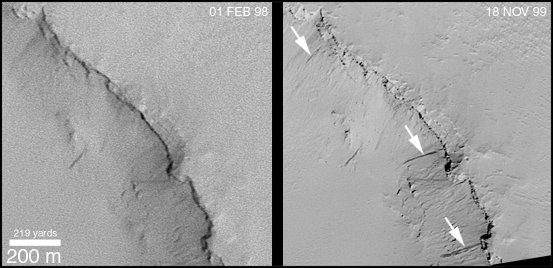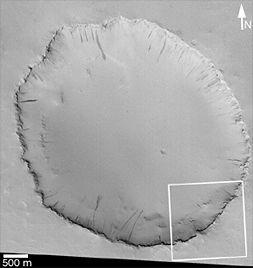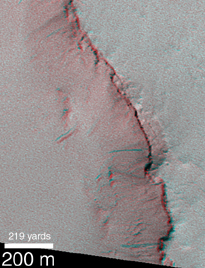Changes between 1 February 1998 and 18 November 1999
 |
Crater at 6°S, 184°W on 01 FEB 1998
 | 3-D Anaglyph View--PIA02380
 |
What is happening on Mars right now? Pictures that show changes occurring from time to time give some clues as to what processes are shaping the modern martian landscape. Dust devils, dust storms, and polar frosts are all known to cause change sin the surface every martian year. But what about other geologic processes? How "active" is Mars today? The Mars Orbiter Camera (MOC) onboard the Mars Global Surveyor (MGS) has been in orbit long enough that it is starting to provide some answers. MGS began orbiting Mars in September 1997. Since that time, it has seen the planet cycle through more than 1 of its 687-Earth-days-long years. The pictures shown here document changes observed by the MOC caused by small landslides.
The picture at the lower left (above) shows a shallow crater located near Apollinaris Patera at 6°S, 184°W, that was photographed by MOC in February 1998. The walls of this crater exhibit approximately 100 dark streaks running down its slopes. These streaks have formed as small landslides or avalanches and are probably composed of sand and/or silt. The image is illuminated by sunlight from the lower left, and the crater is about 5 kilometers (3 miles) across. The white box shows the location of a section of the crater that was photographed again in mid-November 1999, about 92% of a Martian Year later.
The top picture shows a comparison of the southeastern crater wall as it appeared on February 1, 1998, and again on November 18, 1999. (Note that the picture has been rotated relative to the context image at lower left). During the time between the two images, three new dark slope streaks formed (arrows, top right). The older streaks are lighter and fainter than these new, dark ones, suggesting that streaks fade with time. This means that, at least for the crater walls shown here, any streak that is dark is younger than any streak that is pale. The stereo anaglyph (requires red-blue "3-d glasses") at the lower right uses the two images of the crater rim to provide a 3-dimensional view. The anaglyph is helpful to see that the dark streaks really do occur on a slope. In addition, by viewing the anaglyph without 3-d glasses, one can easily identify the three new streaks because they appear as blue and have no red counterpart.
These three new slope streaks formed sometime between February 1998 and November 1999. Similar streaks were observed in the highest-resolution images from the Viking orbiters in the late 1970s, but for more than 20 years no one has known how recent these features might be, or how often they might form. Now, MOC is providing some exciting answers.

